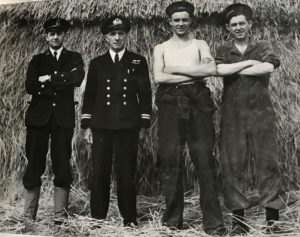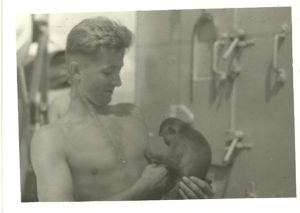
Naval staff at the farm on Tipnor (Courtesy of Brain Witts, Curator of the HMS Excellent collection)
Animal husbandry at HMS Excellent on Whale Island expanded considerably at the onset of the First World War. As it became clear that war to about to break out, the island management began to view the island with different eyes. Although it was surprising that sailors would be put to farming duties, men were tasked with alleviating expected food shortages and addressing potential supply problems. Production of food commenced on a large scale and included a wide range of farmed produce. The farm brought together the military and local community in a mutually beneficial way and was an arena where sailors and civilians worked together. It was a site for an unusual agricultural/maritime synthesis of skills and labour especially in an era when the navy wanted to mirror life at sea within its shore establishments.
The records of animal husbandry on the island have long gone. However, during the research for this work, I was very fortunate to interview one of the sailors who had worked on the island farm as a young Able Seaman in the years immediately after the Second World War. Lieutenant Commander Brian Witts’ recollections are included in the discussion below and help to illustrate the way the farm operated. The farm existed for approximately forty years, and Brian’s account gives a vivid description of the way it was run and how it became part of the local black market economy. Brian is one of the last few people to have considerable living memory of the Island animals and is currently curator of the last remaining photographic and documentary records.
Necessity – the farm as a naval and civilian food supplier
Robert Travers-Young documented that ‘potatoes and other vegetables have been grown in different gardens’ on the island since 1892. Such was the need for supplies that during the First World War he noted that ‘every piece of available ground was put under cultivation, and very profitable crops obtained.’[1] This was described by Brian who commented:
‘There was also a large allotment on the island that produced vegetables etcetera for the sailors to buy, there was a mushroom bed and… well it was a market garden – all money went into the island to pay for seed, feed and tools etcetera.’[2]
Later, the land at Tipnor, just off Whale Island, housed a dairy farm and again there was production of goods that were sold to the local market as Brian noted ‘what we didn’t use on the Island we sold to the locals.’
Market gardening and the farming of animal produce expanded and chicken and pig farming became fairly large scale pursuits. In 1918 officers on the Long Course purchased rabbits for breeding purposes that would help to complement the war rations in force at the time.[3] Poultry farming commenced in 1913 and it developed into a large concern that involved a combination of sailors and members of the local workforce and continued through to the 1950s. Brian described a chicken battery of over 400 chickens with work undertaken by civilian staff supported by sailors, he described how the chickens were sold to sailors who were fed under the old canteen messing system and to the local community. There were strong links between the establishment and local residents and produce was available to both civilian and military personnel.
‘I used to help Harry get ready for the weekend, I dragged the chickens out and wrung their necks and handed them over to anyone buying one.’
And it was not without its trials
‘Once a wife came for a chicken, I wrung its neck- put it in the bag and the bag ran off…the wife never came back again- she was petrified.’
Pig farming was introduced by Commander Bowring in 1917, it was very economical as the pigs were fed with the food waste from the messes.[4] The pig farm became an opportunity for sailors to engage in money making enterprise. There was an extension of the way sailor town economics worked – sailors sold their produce on the local black market and made personal profit, in addition, profits were fed back in to the Whale Island funds and paid for the upkeep of animals as described by Brian:
‘Pigs were sold locally- and the money given to welfare fund and the zoo. It also brought seed for their ground staff. There were rackets being worked with the selling of the pigs and the sometimes chickens from the battery.’
The farm integrated with the local community in a mutually beneficial way
‘I used to take a horse and cart to the hotels in Portsmouth and the Queens Hotel Southsea- loaded with dustbins and collected swill for the animals. The swill was brought back, put in a giant cauldron, mixed with meal and heated and given to the animals. It was usually two ABs[5] with a horse and cart.’
The additional need for animal feed had to be addressed and the feeding of ponies and horses was helped by creating a ready supply of hay and ‘by 1918 three quarters of the lawn was put under hay’. From 1916, hay grown on nearby land at Tipnor was ‘cut and harvested by the ratings on the island’ – this crop proved so successful that the Army was able to buy 130 tons of hay for horses supporting troops on the western front in France.[6]
The island was an excellent food source during both the First and Second World Wars, supplementing other scanty provision, and victuals were provided on the Island and further afield to naval personnel. The enterprising nature of the Whale Island farming effort was demonstrated by the response to sugar rationing in January 1918 – immediately ‘three swarms of bees were brought and placed in hives in the rose garden’; thus producing honey as a sugar replacement for the sweetening of drinks and food. [7]
The farm expanded into other areas of enterprise, for example Brian detailed:
‘There was a greenhouse at the far end of the wardroom. You could get bedding plants and flowers. For 10s you could pick up a chicken and a bunch of flowers from the gardener to take home. The cost of up-keep of the animals was met by the farming profits.’
We see then, sustainable farming providing food for the ships company and to the wider local community, sailors and civilians accomplished high quality animal husbandry and enterprising market gardening. The pig and chicken farms were closed in the 1950s, and farming ended when the naval messing system changed from canteen to general messing and the introduction of refrigeration for stores, and with it the last vestiges of animal husbandry on the island apart from a few pet dogs.
The zoo and farm were a uniting force that enriched sailor life on the island, they were a multirank work force that combined with the local community to provide both an enchanting haven for its inhabitants and a valuable food source. It was a place of sanctuary for sailors and animals, where rural practices took place alongside the urban and maritime environments, a site of resistance to modern naval life and part of the wider sailor town exchange of goods and services, thus being a realisation of the synergy between the naval and civilian community in Portsmouth.
I am very grateful to Lieutenant Commander Witts for his help with this research, his knowledge and memories made the story of the zoo and farm come alive.
Read Part 1 – The Sailor Zoo
Notes
[1] Robert Travers-Young. The House that Jack Built: The Story of HMS Excellent. Aldershot: Gale and Polden Ltd, 1955), 82.
[2] Interviews with Lieutenant Commander Brian Witts MBE RN conducted in August and September 2017 at HMS Excellent Museum, Whale Island, Portsmouth.
[3] Anon. A Short History of Whale Island. (Compiled from Information supplied by Past and present Officers and Men, 2nd ed. ( Portsmouth, Charpentier and Co., Naval printers, 1919).
[4] Anon. A Short History.
[5] Able Seamen.
[6] Anon. A Short History.
[7] Anon. A Short History.











Comments are closed.